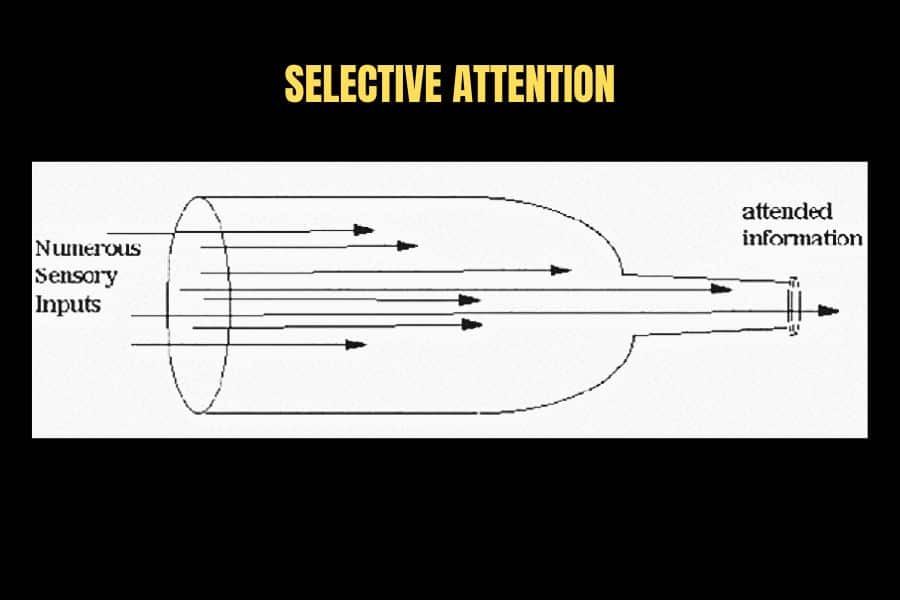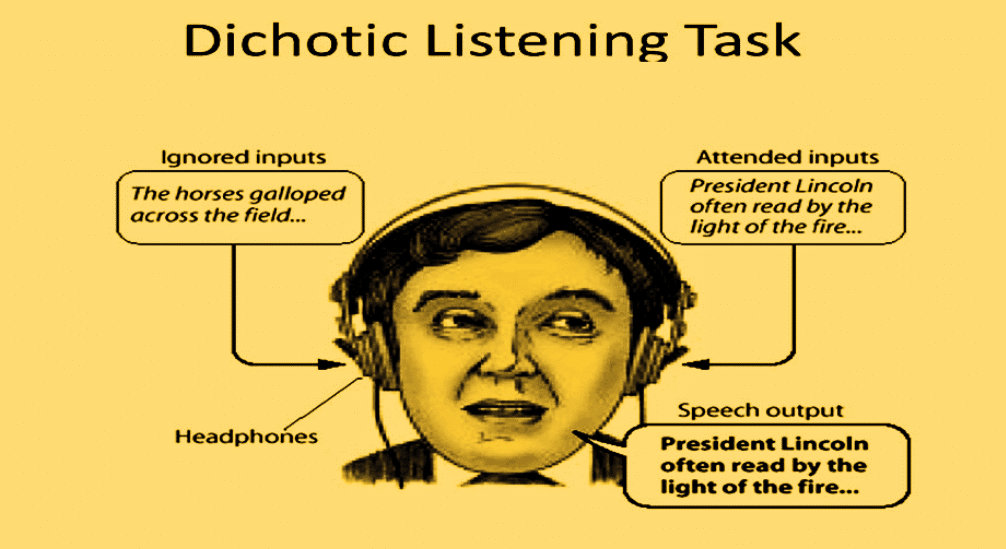Discover the captivating life and ground-breaking research of Donald Broadbent, the star in the field of psychology. Dive into his biography, from his childhood to the most admirable part of his career, a psychologist whose accomplishments include the Nobel Prize. Enhance your understanding of the remarkable Broadbent’s filter model as you explore its main elements and the contribution to human cognition research that it made.
Examine Broadbent’s filter theory, and sentence down its core thesis and practical utilization in selective attention understanding. Plunge into dichotic listening experiments which clear the role they play in advancing our understanding of attentiveness and perception.
Discover Broadbent’s enduring legacy and his far-reaching impact on psychology, narrating his discoveries and apprehensions that have led to the expansion of the psychology discipline.
Discover what knowledge is contained in Donald Broadbent’s books and quotations, giving those who read them a deeper understanding and motivation. Join us on this great and informative voyage, where knowledge and comprehension are harvested from the ingenious mind of Donald Broadbent.
Table of Contents
Donald Broadbent’s Biography
Early Life
Donald Broadbent, a British cognitive psychologist’s colossi, was born in 1926 in Birmingham, England. He gained curiosity about the workings of the mind during his early years. This was to be the starting point of his future psychological studies.
Education
Broadbent’s academic journey began at the University of Cambridge, where he earned a degree in Natural Sciences. His psychology interest led him to undertake post-graduation studies in psychology, ending finally with a Ph. D. Psychology degree obtained from the University of Cambridge.
Career Journey as a Psychologist
Broadbent’s psychological career was marked by cutting-edge research and creative thinking. The starting point of his professional life was the Applied Psychology Unit in Cambridge, during which he carried out pioneering research using experimental methods on perception and attention. Broadbent’s first experiments paved the way for his popular Broadbent theory of attention and Broadbent’s filter model.
Notable Achievements and Awards
During his long and distinguished career, Broadbent earned several prizes and awards for his work in psychology. His influential work on attention and perception led him to be honored by prestigious organizations like the British Psychological Society and the American Psychological Association. Broadbent’s novel concepts and research results are still a foundation of our cognition understanding, which plays an important role in perception and communication.
What Is The Broadbent Model of Attention?
Understanding the Broadbent Model of Attention
The Broadbent theory of attention containing key aspects has restructured the research field of attention, perception and communication. Through this model, it is proposed that sensory data initially go through filtering-based physical traits only before cognitive processing.
This filtering occurs during the beginning of the processing stage of the brain, in which the early factors, such as the pitch or the location, rather than the semantic content, dominate.

Key Components
The model consists of a buffer for the sensory component, a selective filter, and lastly limited capacity channel for perception and response. The sensory information passes out of the sensory buffer, where it is briefly saved.
Nevertheless, such a selective filter operates so that only relevant info is allowed to be directed from subconscious awareness to further processing, while all the rest of the redundant info is discarded. This filtering is a process without which our system of limited human cognitive processing would be impossible.
How It Revolutionized The Study of Attention
Broadbent theory of attention reflected a revolution from previous perspectives that mostly emphasized conscious control mechanisms. The model mainly emphasized automatic processes that were responsible for selecting and processing the sensory information in the complex surroundings.
Through this paradigm shift, new observation methods and theoretical models for attention, perception and communication were developed. These interdisciplinary studies started in psychology, neuroscience, and cognitive science.
Sensory Register
The sensory register is also related to the Broadbent theory of attention. In Broadbent’s model, sensory data is stored in a temporary sensory buffer where they are discriminatively held based on individual features, such as visual attributes or word meanings. Attention is allocated to such specific details, while the rest is discarded.
This kind of process reminds us of initial storing and filtering as is described in the Atkinson-Shiffrin model. Attention is the focus of both approaches; however, they differ concerning the selection and processing of sensory input.
Comparing Broadbent’s Model to Other Theories
Unique Aspects
One of the distinctive elements of Broadbent’s model is the early, automatic selection of attention in stimuli processing. This model included more intricate processing stages and feedback loops and was much better in explaining attentional selection based on some filtering mechanisms. This simplicity led to obtaining transparent predictions and testable hypotheses for the experimental methods of research.
Implications For Psychology
Broadbent model’s foremost stage of filtering has deep implications in understanding selective attention, divided attention, cognitive load, perception and communication. This model qualifies how the selection operates and makes contributions to the theories of memory, decision making, perception and communication which places the interactions people have with their environment and the ability to process information in real-time in a new light.
Besides human factors, education, applied psychology, experimental psychology and clinical psychology where attention process modification is essential, the model has practical impacts in these fields.
What Is The Filter Theory By Donald Broadbent?
Donald Broadbent’s Theory
Donald Broadbent’s filter theory which he presented in the 1950’s transformed the way we perceive selective attention. The gist of the Broadbent’s filter model is that the mind acts as a selective filter, based on certain criteria, while excluding unimportant stimuli.
This filtering process helps individuals to focus on the information that is most important to them, at the same time, blocking out distracting elements resulting in better cognitive functioning and memory storage.

Key Principles of The Theory
The Broadbent’s filter theory proposes two important assumptions that support its framework:
- Selective Attention: This theory suggests that people cannot process all incoming information at once because of the limits on their cognitive abilities. In contrast, it is the mind that chooses to focus on certain stimuli and filter out others based on different factors including relevance, importance, and salience. This selective attending process allows people to channel their cognitive resources to the stimuli that are perceived as the most vital or meaningful at any given moment.
- Limited Capacity: Broadbent filter model suggested that there is a limited capacity for the brain to process information, thus there must be a mechanism for selective filtering. This constrained capacity is demonstrated in various cognitive tasks like perception, memory storage, and problem-solving where attention is selectively shifted among stimuli to prevent cognitive disengagement. The Broadbent filter model underscores the adaptive nature of selective attention, pointing out its role in enhancing cognitive performance under conditions of limited memory storage capacity.
How It Addresses Selective Attention
A comprehensive theory of Broadbent’s filter approach explains the mechanism of how an individual selectively attends to and processes the incoming sensory information. The Broadbent filter model explains attentional operation processes by giving an overview of how the brain filters out irrelevant stimuli while prioritizing relevant ones.
Through the selective filtering process, individuals can effortlessly cope with the difficulties of multifaceted situations by paying attention to the important stuff and ignoring the unimportant.
Applications of The Filter Theory
Insights Into Information Processing
The Broadbent’s filter theory has contributed greatly to the understanding of how human beings perform information processing. Researchers make use of the Selective Attention model as a tool to understand different cognitive phenomena such as attentional biases, dual-task performance, and divided attention. Through this way of learning the researchers can delve deeper into the intricacies of attentional process and the implications for human cognition.
Practical Implications in Everyday Life
Practical Implications of the Filter Theory in everyday life are given below:
| Donald Broadbent filter theory principles have practical significance in communication, education, applied psychology and technology design just to highlight a few domains. |
| Likewise, advertisers can harness selective attention, when they create messages which are alluring and they can effectively catch consumers attention. |
| In addition, teachers can make training materials and teach methods to fit the attention range of students, increasing memory storage and learning effectiveness. |
| Similarly, interface designers from the tech industry may apply the Broadbent’s filter model in their design to build interfaces that limit the amount of cognitive load and quickly process the information. |
Dichotic Listening Experiments
Overview of Dichotic Listening Experiments
Definition and Purpose
Dichotic listening experiments are a method that is used in psychology to research selective attention and perception. These experiments use headphones to deliver various audio stimuli to each ear simultaneously. Subjects are then required to concentrate on one message (usually presented to one ear) and disregard the other message (presented to the other ear).
These experiments aim to shed light on how the brain decodes and ranks the incoming auditory information when multiple stimuli are competing.

Connection to Broadbent’s Theories
These studies are closely associated with the theory of Donald Broadbent, especially Broadbent model of attention. Broadbent’s model assumes that attention is the gatekeeper, allowing only certain things to pass for subsequent processing.
Dichotic listening experiments offer the opportunity to investigate the mechanism of selective attention since the presentation of stimuli to both ears is controlled and the response can be observed.
Cocktail Party Effect

The cocktail party effect is a term for our ability to find a single conversation amid many other conversations, which can take place at a loud party. Against a background noise, the brain can filter out all the irrelevant information, making it possible for the individual to focus on the conversation.
It is based on cognitive skills, such as auditory processing and attention mechanisms, helping the brain to focus on relevant stimuli. In other words, this experiment shows the brain’s outstanding capacity for dividing and processing complex acoustic information, thereby communication and social interaction are improved even in noisy settings.
Findings and Contributions
Results of The Experiments
Throughout the history of dichotic listening experiments, several impressive results have been obtained. For instance, researchers have documented that people tend to remember better the information presented to the attended ear than the information presented to the unattended ear. This phenomenon, the shadowing effect, appears as a remarkable example of the brain’s selective capacity to concentrate on a particular stimulus and filter out others.
On the other side, varying in type of demands and stimuli features including pitch or semantic context may facilitate or reduce selective attention to one message instead of another.
How They Contribute to Understanding Attention and Perception
These tests are considered the key to the discovery of the principles that rule selective attention and perception. Researchers can investigate the real-time attentional mechanisms by modifying the stimuli that each ear receives and examining how participants respond. Not only does this knowledge help us understand fundamental cognitive processes, but it also has useful applications in different industries.
The knowledge of how attention works can help researchers in both cognitive psychology and neuroscience create treatments for diseases about attention. Dichotic listening exercises can be an effective therapy tool in diagnostics such as auditory processing disorder screening.
Donald Broadbent’s Contribution to Psychology
Donald Broadbent’s Influence on Modern Psychology
The impact of Donald Broadbent on contemporary psychology is striking, especially in the sphere of cognitive psychology. His revolutionary theories and studies form the basis upon which modern psychologists build their understanding of human cognition and behavior.
Broadbent’s work opened the door for more advanced studies, where the attention, memory, and perception processes became more clear. His inventive methods of researching cognitive issues brought positive change and encouraged generations of scientists to follow new paths.
Legacy in Cognitive Psychology
The perspective of Broadbent is still alive because his thoughts influence the future of cognitive psychology research and theory development. The Broadbent model of attention, for example, is considered an integral part of the study of the attentional process. Researchers can design their experiments based on this model.
Furthermore, Broadbent’s findings on the cognitive process of selective attention and short-term memory have reshaped our understanding of human ‘memory’, offering new insights into the storage and retrieval of memories.
Influence on Subsequent Research and Theories
Along with his research, Broadbent has also inspired others in the field of cognitive psychology, as his ideas have been used in investigations and refinement of the discipline. Scholars in the field have refined Broadbent’s theories and built on them, also adding new ones. These follow the pattern of Broadbent’s ideas but also incorporate his discoveries.
As another example, his concepts of attentional and information processing have been combined with larger theories of cognitive control and executive function, thus extending our knowledge of higher-level cognitive processes.
Significance of His Work in Advancing Psychological Understanding
Broadbent’s theories have great implications for both theoretical knowledge and practical experience. He has explained these mechanisms well thus enhancing comprehension of the primary function that is human cognition.
These deeper insights are not only meant to contribute to theoretical understanding but also be used in practical applications like education, human-computer interaction, and clinical psychology. Bradbent’s research is the basis for the resolution of issues and improvement of lives using science-evidence interventions and strategies.
Donald Broadbent’s Books

Broadbent, a prolific author, wrote several influential books on psychology. Here are some noteworthy works by Donald Broadbent:
| “Perception and Communication“ | Investigates the link between perception and communication, shedding light on fundamental cognitive processes. |
| “Decision and Stress“ | Investigates decision-making and stress’s effects on cognition, providing insights into coping strategies. |
| “Attention and Performance“ | Examines the function of attention in human performance, focusing on behavior and cognition. |
Donald Broadbent’s Quotes
Here are five excellent quotes from Broadbent.

” Attention is the key to perception and cognition.”
“The mind is not a passive recipient of information, but an active processor.”
” Memory is the foundation of knowledge, and its development begins in childhood.”
“Understanding the mechanisms of attention is crucial for unlocking human potential.”
Conclusion
In summary, Donald Broadbent’s journey through psychology has affected him profoundly. Ranging from his early days to the moments of glory, Broadbent’s biography is the embodiment of his devotion. In the course of this article, the Broadbent model of attention and the filter theory were introduced as extremely important psychological approaches.
The Broadbent model has remodeled our perspective of attention, whereas the filter theory provides practical lessons in selective attention. Dichotic listening experiments added more evidence to Broadbent’s theories, giving us a better understanding of attention and perception. His role in psychology goes beyond theories, directing future research and theories.
Broadbent’s contribution to cognitive psychology and the development of our knowledge of human cognition, through his legacy, clearly shows how important he was. Contemplating his books and sayings, we are inspired by his lasting importance to psychology.
FAQS
What were Donald Broadbent’s main contributions to psychology?
Donald Broadbent made major contributions to psychology about attention, perception, and memory. He presented theories like the Broadbent model of attention and the filtering model, which had a great impact on the way we comprehend cognition.
What is the Broadbent model of attention?
The Broadbent model of attention suggests that the filtering mechanism works to enable only the relevant information to be processed while muting the irrelevant stimuli. It pinpoints the involvement of sensory inputs and selective attention in cognitive operations.
How did Donald Broadbent’s research impact the field of psychology?
Broadbent’s work was pioneering because it shed light on basic cognitive operations like attention, perception, and memory. His theories paved the way for further work in cognitive psychology and remain relevant to the field today.
What is the filter theory proposed by Donald Broadbent?
According to the filter theory, selective attention acts as a filter, admitting only some stimuli while filtering out irrelevant information. It elucidates how a person takes in focus on certain stimuli and ignores others, which can be very helpful in information processing.
What were some of Donald Broadbent’s notable achievements and awards?
Donald Broadbent was awarded a bunch of prizes and honors for his revolutionary works in psychology. He gained the recognition of professional establishments such as the British Psychological Society and the American Psychological Association for his work on attention, perception, and memory. His work remains admired for its long-lasting influence on the field of psychology.













